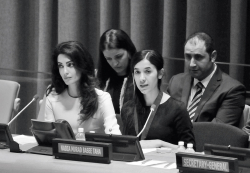Robert Guest in The Economist:
 They make an unusual team. Amal Clooney is an Oxford-educated human-rights lawyer married to a film star. Nadia Murad was born in a poor Iraqi village and once aspired to become a teacher. Clooney is tall, dazzling and so recognisable that people walk up to her in the street and tell her they love her. Murad is small, shy and avoids eye contact. Yet among her people, the Yazidis, Murad is better known and more admired than any other woman on Earth. Murad is a symbol of survival for a minority threatened with extermination. She was once a slave of Islamic State (IS). And, almost alone among former prisoners of IS, she is willing to testify publicly and repeatedly about the terrible things the jihadists did to her. Clooney is Murad’s lawyer, and the two women are working to bring the leaders of IS before an international court for inflicting genocide on the Yazidis. The story of their campaign is an extraordinary one: a tale of pious savagery pitted against truth, law and the soft power of celebrity.
They make an unusual team. Amal Clooney is an Oxford-educated human-rights lawyer married to a film star. Nadia Murad was born in a poor Iraqi village and once aspired to become a teacher. Clooney is tall, dazzling and so recognisable that people walk up to her in the street and tell her they love her. Murad is small, shy and avoids eye contact. Yet among her people, the Yazidis, Murad is better known and more admired than any other woman on Earth. Murad is a symbol of survival for a minority threatened with extermination. She was once a slave of Islamic State (IS). And, almost alone among former prisoners of IS, she is willing to testify publicly and repeatedly about the terrible things the jihadists did to her. Clooney is Murad’s lawyer, and the two women are working to bring the leaders of IS before an international court for inflicting genocide on the Yazidis. The story of their campaign is an extraordinary one: a tale of pious savagery pitted against truth, law and the soft power of celebrity.
It begins in August 2014, when Murad was a 21-year-old student. That month, IS fighters arrived in her village, Kocho, on the Nineveh plain. They were a terrifying mob, all of them heavily armed and many speaking languages that no one in Kocho understood. The jihadists saw Nadia and her neighbours as the worst sort of infidels. The Yazidi faith has no holy book, but draws on a mix of Mesopotamian traditions. Yazidis revere a peacock angel that temporarily fell from God’s grace; many Muslims regard this as devil-worship. Estimates of how many Yazidis there are range widely, from 70,000 to 500,000, mostly in Iraq but also in Syria and Germany. IS set out to reduce that number to zero, by forced conversion or Kalashnikov. On August 15th the IS fighters in Kocho summoned everyone to the village school and separated the men from the women and children. Nadia watched from a second-floor window as they marched the men away. They slaughtered 312 in an hour, including six of Nadia’s brothers and stepbrothers. They murdered the older women, too, including Nadia’s mother. They forced the young women and children onto buses and took them to Mosul, IS’s main stronghold in Iraq, which, as 1843 went to press, was under siege by Iraqi government forces.
Nadia was shut in a building with 1,000 other families. The women were sick with fear; they knew what was coming. The fighters were about to divide the spoils. A man came up to Nadia and said he wanted to take her. She looked up and saw that he was enormous, “like a monster”. “I cried out that I was too young and he was huge. He kicked and beat me. A few minutes later, another man came up to me…I saw that he was a little smaller. I begged for him to take me.” The jihadist who took Nadia told her to convert to Islam. She refused. One day, he asked for her hand in “marriage”. She said she was ill. A few days later, he forced her to get dressed and put on make-up. “Then, on that terrible night, he did it.” From then on, she was raped daily. When she tried to flee, a guard stopped her, forced her to strip and put her in a room with several guards, “who proceeded to commit their crime until I fainted”. She finally escaped when her captor left a door unlocked. She could not return home, because IS still controlled her village. Eventually, she found sanctuary in Germany, where she now lives.
More here.
Seventy years ago, the state of Israel was still just a gleam in Zionists’ eyes, and the future state’s military was hardly more than a ragtag group of irregulars, forced to manufacture bullets in a secret facility built underneath a kibbutz. Today, Israel’s military is widely viewed as one of the most effective in the world. Once compelled to arm itself with surplus equipment purchased from more powerful states (and sometimes obtained by stealth), Israel is now one of the world’s six largest arms exporters, earning billions each year through the sale of military equipment to buyers from China and India to Colombia and Russia.
